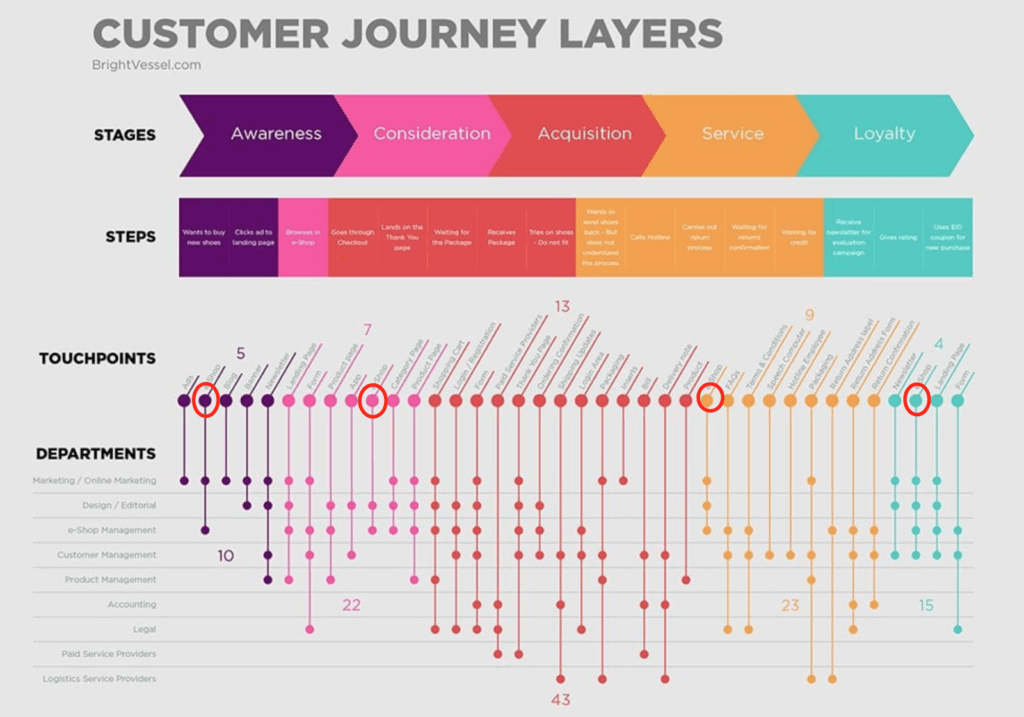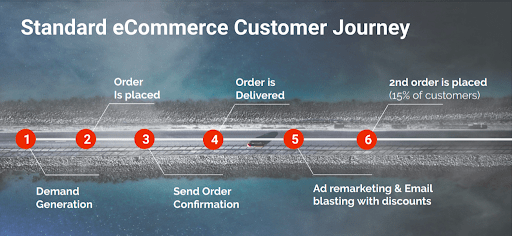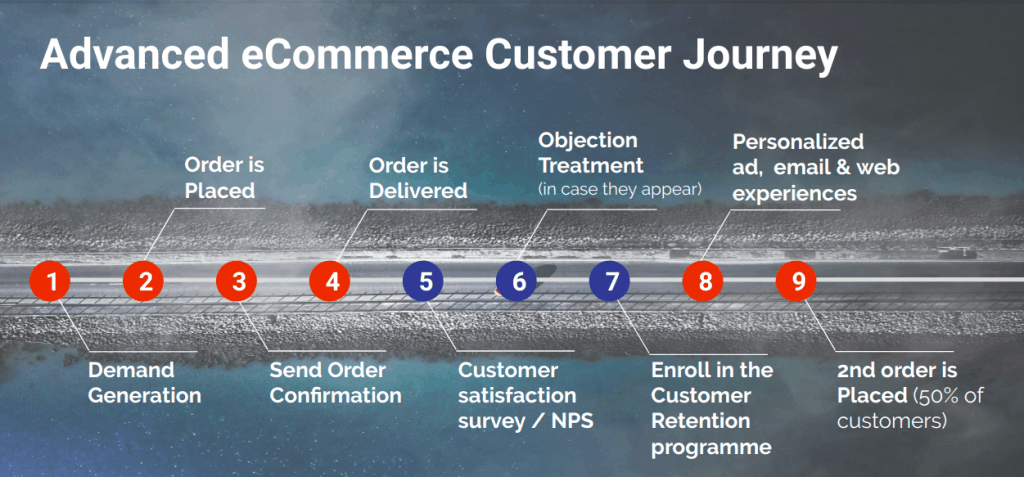The reimagining of CRO into one element of the wider CJO is undeniable and we see proof of that more and more.
The e-commerce environment has changed in a very short period of time due to the covid pandemic which has created new types of buying behaviors and new types of users.
Many companies have seen CRO (conversion rate optimisation) as a magic formula to generate more revenue overnight.
Few companies understand that CRO can often be a fix for badly designed websites, which are a part of the digital customer journey, which is a part of the broader customer journey.

There are clear signs that conversion rate optimisation will transform into a more comprehensive, strategic method to create much better customer journeys.
Few companies understand that with all this fierce competition going on, CRO and acquisition are just a part of the customer journey optimisation puzzle.
Besides this, you need to analyse all the touchpoints where your customers, visitors or prospects are interacting with your business. This can result in agencies and freelancers promising to deliver silver bullets to become a thing of the past.
Personalising your customers’ journey is a huge step towards delighting your customers and helping them become return customers, which, in turn, will help increase customer lifetime value – your path towards e-commerce business growth.
Here are a few interesting numbers to check out first:
- A customer experience mindset can drive revenue of 4-8% higher for one company than its competition.
- 84% of companies improving their customer experience report an increase in their revenue.
- 96% of customers consider customer service crucial when choosing where to place their brand loyalty.
- Loyal customers are five times more likely to purchase again and four times more likely to refer a friend to the company.
- Companies creating strategies to improve their customer experience report an employee engagement increase by 20% on average.
What is Customer Journey Optimisation?
Customer journey optimisation means keeping your customers’ needs and interests at the heart of every stage of their journey and providing them with solutions to keep them going to the next step.
Customer journey optimisation starts from the customer journey map that identifies the omnichannel customer needs and pain points. Customer journey mapping is the best way to visualise how a customer interacts with your business.
The key here is to establish a relationship with your customers, helping them build trust towards your brand. How to do that? You need to research:
- Map out the touchpoints in the customer journey
- Identify customer behavior
- Identify the strong points and weaknesses in each touchpoint
- Segment your customers
- Create customer management and internal process monitoring.
Why should you apply Customer Journey Optimisation to your business?
This is how a simplified version of an e-commerce customer journey looks:

A more advanced customer journey looks like this:

Mapping your customers’ journey is the first step to understanding their pain points, goals, emotions, and determine an ICP (ideal customer profile) which shows:
- Who your customers are – location, gender, age
- Their buying habits – when they buy
- What your customers buy – product assortment anomalies
- Why are they coming back – reasons and barriers
- What they expect further – qualitative research.
Building the ICP will significantly improve your user acquisition performance and further communication with your customers.
Analysing your customer journey map will:
- Let you see where, when and how your customer engages with your business, letting you know where your resources should be invested more often
- Attract your attention to certain customer needs in some stages of the buying process (awareness, consideration, decision, delivery and use, retention and advocacy)
- Show you if the customer experience you desire for your clients is actually the real experience they encounter
- Identify whether the process of buying from your company is easy, efficient and logical
- Shed light on future development plans needed for the company’s evolution and in order to improve customer experiences and customer success.
Here are a few examples of practical actions you can take during each stage to keep your customers on the right track:
- In the awareness stage, you can do anything from educational and engaging content, to well-designed and optimised online ads.
- The consideration stage is for those customers who have already acknowledged your product/service, but are unsure what to decide. Your website structure is crucial at this phase: take special care of how you design your categories, landing pages, contact form or app. Email marketing and remarketing also come into place here.
- The decision phase is where you can play the most: look into the shopping cart section, login/registration page, thank you page (crucial for the analytics part afterwards), shipping updates, packaging, delivery note, surveys before purchase and so much more.
- The delivery and use phase brings in new actions to take: FAQs, terms and conditions, live chat available, returns policy, but also delivering surveys post-purchase.
- The retention and advocacy phase is the gold mine of every business. Be sure to send proper newsletters, discounts for your most loyal customers, appreciate their word-of-mouth efforts to promote your brand, use remarketing to showcase related products/services, check in on your customers and their feelings post-purchase.
Top 5 expert opinions on customer journey optimisation
- The Conversion Rate Experts team has confirmed their belief in CRO being integrated into customer journey optimisation. They make two mentions:
- Content can be represented by a landing page, but it can also be a checkout page, an explainer video, the warranty application card that comes with a product, an email asking customers to refer their friends, the sales script that a customer service operator uses, a radio ad or an entire website.
- The general goal is to optimise the content for what it was created for.
- Shiva Manjunath, from Gartner, goes further and makes a point that if you are not using experimentation beyond the purpose of the user interface, you are missing out. He also reminds us of the various uses of experimentation:
- To test marketing principles
- To test the value of core business units
- To enhance post-login experiences
- To identify how new tools/technology will impact your site
- Valentin Radu, from Omniconvert, makes the difference between customer acquisition and customer retention and how unhealthy it is for a company to focus only on the acquisition part. The conversion rate compiles new customer acquisition rate and also customer retention rate, which means that in order to improve the conversion rate, companies must also understand the big picture: the customer lifetime value, the customer experience and various hidden aspects that make the company profitable.
- Hugo Hamel, from Enrich, warns that businesses which are not improving their conversion rate, in most cases, are not improving their customers’ experience. This also means that they are not improving their customer journey, because any touchpoint should be optimised. He goes further and tells us that there’s no such thing as a simple quick fix like changing the font or colour of a button. While it might help or be part of the solution that helps you increase your conversion, the real root of the problem is usually much deeper than just a quick fix. You have to research, hypothesise, test and repeat, in order to optimise something.
- Arjen Koedam, from arjenkoedam.com, shares his thoughts with a clear view: CRO has always been part of optimising the customer journey, but to make it a sustainable strategy, customer satisfaction should be at the core of it. When thinking about how to optimise the customer journey, most people think about how to get the customer down the funnel as fast as possible. The primary focus is on CRO, however: how to convert a lead or visitor into a customer. This approach theorises about the customer journey in a linear way, while in practice it is not. He suggests a customer-centric approach where the goal of the conversion is not a direct line towards a sale, but customer satisfaction. It is more valuable to help a visitor of your website with content that actually solves a problem for him than it would be to sell him a product that does not solve his problem.
Conclusions
Customer journey optimisation is closely related to the company’s behavior towards the client. Do you care about the customer? Do you understand their pains? How can you help them overcome their pains and delight them throughout their journey?
Be wary of their behaviour at each step down the road and optimise your content and strategies accordingly. The results will amase you in the long term!
If you want an essential tool for Customer Journey Optimization and Customer Journey Analytics, here it is: try Reveal on Shopify.
About the author
Andrada Vonhaz is a digital marketing specialist at Omniconvert. Passionate about marketing and the dynamism of technology, Andrada started by understanding the basic steps of content and copywriting and social media, SEO & PPC back in 2016. Combining this knowledge, she was able to create marketing strategies, to develop project management skills, to communicate and monitor marketing activities, from a simple idea to the completion of a project.



